-
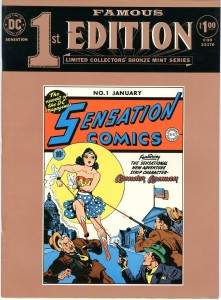 So this review seems particularly retro. It’s one thing to review a book which came out during or right after World War II. Books tend to stay in print for decades, if they’re deemed worthy. But a ten-cent comic book from 1942? 70 years after-the-fact may seem a bit late to be telling you how great it was, especially since getting hold of a copy is a little more expensive, comparatively, than securing a copy of The Humanoids or Friday. Looking on eBay just now, I see that an original copy runs five figures – the bid is up to $11,614 in one auction, and there’s a “buy it now” copy priced at $17,252. A reprint costs roughly $20 – It’s only been reprinted twice, to my knowledge – or you can pay about $50 and get just the Wonder Woman lead story if you pick up the first volume of the Wonder Woman Archives. But getting just the Wonder Woman story would be missing the point. Sensation Comics #1 represents the Golden Age of Super-Hero comics hitting its stride. It marks the moment when the writers, editors and artists “got it.” and put together a product that absolutely captured the spirit of its time. A close contender would be All-Star Comics #3, which introduced the Justice Society of America. But it’s only a close contender. I shall explain why I think so as I go.
So this review seems particularly retro. It’s one thing to review a book which came out during or right after World War II. Books tend to stay in print for decades, if they’re deemed worthy. But a ten-cent comic book from 1942? 70 years after-the-fact may seem a bit late to be telling you how great it was, especially since getting hold of a copy is a little more expensive, comparatively, than securing a copy of The Humanoids or Friday. Looking on eBay just now, I see that an original copy runs five figures – the bid is up to $11,614 in one auction, and there’s a “buy it now” copy priced at $17,252. A reprint costs roughly $20 – It’s only been reprinted twice, to my knowledge – or you can pay about $50 and get just the Wonder Woman lead story if you pick up the first volume of the Wonder Woman Archives. But getting just the Wonder Woman story would be missing the point. Sensation Comics #1 represents the Golden Age of Super-Hero comics hitting its stride. It marks the moment when the writers, editors and artists “got it.” and put together a product that absolutely captured the spirit of its time. A close contender would be All-Star Comics #3, which introduced the Justice Society of America. But it’s only a close contender. I shall explain why I think so as I go.
First, some personal history. (Yeah, some personal history again. Are you sensing a theme? The old man’s gonna tell another story from his past? Well, that’s why you’re here, isn’t it? Lord knows it’s not for the free coffee and donuts, ‘cause my staff already ate those. Greedy buggers.)It was the Summer of 1974, and I was spending the weekend with my Uncle’s family in Hyattsville. It being hot, my cousins and I had trudged to the nearest strip mall (though we didn’t know that term then) and hit the 7-11 for Slurpees. They came in DC Super-Hero collectible cups. The cup of the week or the day was Wonder Woman. (Was there a cup of the week or the day? I don’t know how they distributed them. There were dozens in the series, and I think they only had them for the Summer. So I don’t know what determined which cup you got. I just know I got two Wonder Woman cups that weekend.)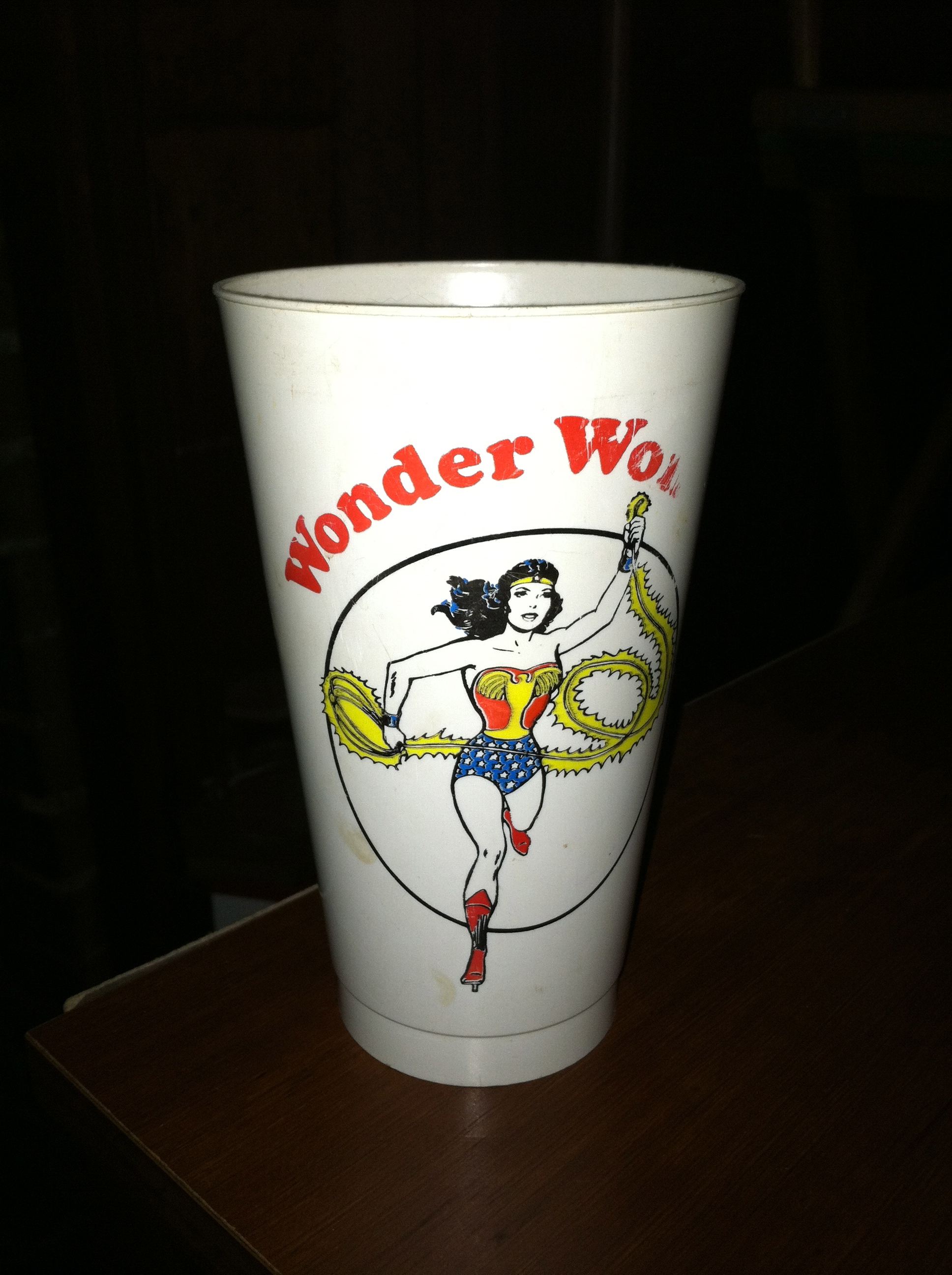 Back at the ranch (a 1965-vintage rancher, to be precise) I asked my Uncle Bob, a big comic book fan himself, just who this Wonder Woman chick was anyway. (Chick. Wow. Disrespectful. I hadn’t been enlightened. Actually, my almost-nine-year-old self almost never called women “chicks.” I embelish to heighten the dramatic contrast.) I’d seen her on SuperFriends, which had premiered the previous Fall, but I didn’t know where she came from. Superman everyone knew, Batman and Robin had that cool TV show that was still running every day, and I guess I took Aquaman as read; but where did they get Wonder Woman? Uncle Bob handed me a repro of Sensation Comics #1 and said something on the order of “this will tell you all you need to know.” Bob has a Clint-Eastwood quality to his voice, and a born storyteller’s intonations, inherited from his mother. To an almost-nine-year-old boy, hearing this conveyed a sense that the secrets of the universe were just within reach.
Back at the ranch (a 1965-vintage rancher, to be precise) I asked my Uncle Bob, a big comic book fan himself, just who this Wonder Woman chick was anyway. (Chick. Wow. Disrespectful. I hadn’t been enlightened. Actually, my almost-nine-year-old self almost never called women “chicks.” I embelish to heighten the dramatic contrast.) I’d seen her on SuperFriends, which had premiered the previous Fall, but I didn’t know where she came from. Superman everyone knew, Batman and Robin had that cool TV show that was still running every day, and I guess I took Aquaman as read; but where did they get Wonder Woman? Uncle Bob handed me a repro of Sensation Comics #1 and said something on the order of “this will tell you all you need to know.” Bob has a Clint-Eastwood quality to his voice, and a born storyteller’s intonations, inherited from his mother. To an almost-nine-year-old boy, hearing this conveyed a sense that the secrets of the universe were just within reach.I settled into the couch and, for probably an hour, ignoring the pleas of my cousins to come out in the yard and convert it into the Argonne Forest, complete with trenches and cardboard shanties, or whatever the plan was that particular Summer day. I met Wonder Woman, as originally conceived by William Moulton Marston, a weird little psychologist who also invented the lie detector, so it says here. She was much prettier than her television incarnation. She had sculpted features which reminded me of my chorus teacher, of whom I was very fond. She had a boyfriend named Steve, so a regular guy stood a chance. Best of all, her origins were rooted in Greek mythology. I had just discovered the Greek myths that Winter, when the school librarian had read us the story of Jason and the Argonauts from D’Aulaires’ Book of Greek Myths. (Note to self – must review that book!) I was fanatical about the stories of the gods and heroes, and Princess Diana just added more depth to my fascination.
So there’s my first bullet-point on why Sensation stands above the rest: a female lead. Girls could play the Super-Hero game too. Perhaps that’s an odd thing to appeal to a pre-adolescent boy, but, at eight, I already knew that I’d rather look at a pretty girl than a smelly old boy or man. So much moreso if you offer me the choice between a thirties-vintage wrestler type like Superman in tights, or an elegant beauty like Wonder Woman in a short skirt. I always liked girls. I did not exclude them from playground games, and I didn’t think they should stand in the corner and cower in stories, either. That’s probably why a story like Jason and the Argonauts grabbed me – Medea the sorceress kicked ass! (And slit her children’s throats, but I didn’t know that until later.) The Justice Society, when first introduced, was a men’s club. That seemed dull to me.
But if Wonder Woman were all there was to that comic, then the 12-page reprint in the archive volume would be enough, and I wouldn’t be calling this 64-page volume the pinnacle of Golden Age comic publishing. Action Comics, Detective Comics, Adventure Comics, More Fun Comics, Flash Comics Star-Spangled Comics and All-American Comics were the others in the National Periodicals fleet. (Other companies were publishing comics as well, including Timely, which would become Marvel, and was already distributing Captain America, Sub-Mariner and Human Torch stories, among others. National, soon to be “DC,” was king, however. They were there first, and their books seemed to be better-distributed than their competitors’, save perhaps those put out by Fawcett, which included the Marvel Family.) All the other National titles largely featured one or two super-heroes, filling out the book with cowboys, hard-boiled detectives, magicians and aviators – essentially, the archetypes of pulp fiction. Several of these strips, early on, were even two-color or black and white. Sensation was the first to feature, pretty much across the board, costumed “mystery men” (and women.) Again, All-Star was the exception, but it assembled characters from other books.
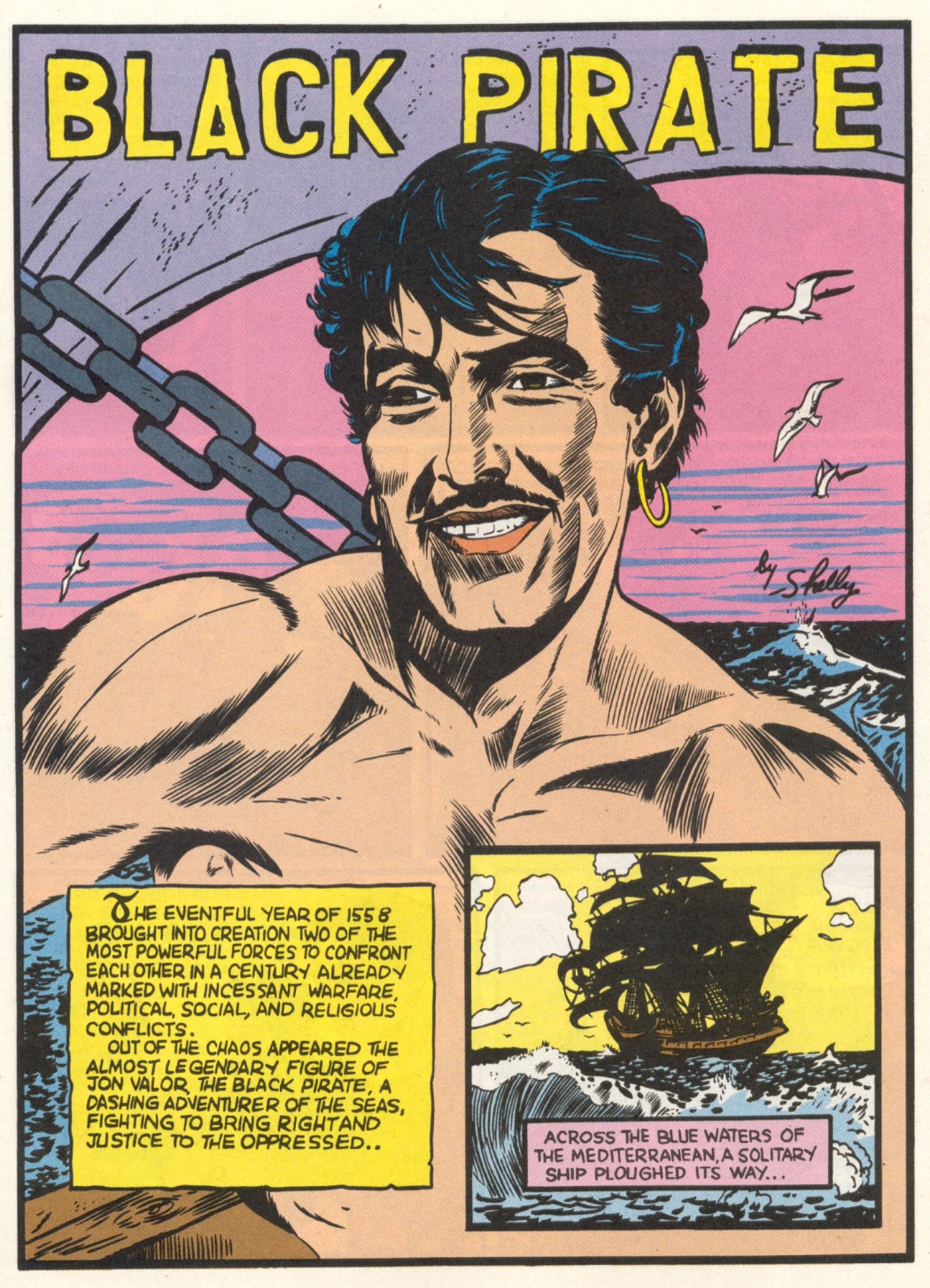 The Black Pirate, at first glance, seems more the stuff of pulps as was fodder for other comic magazines. Indeed, this was the only Senation feature which had originally appeared elsewhere. Jon Valor, a privateer sailing the high seas in the mid-1500s, had first appeared in Action Comics #23. Very “Hal Foster” in its style of artwork, this strip has little dialogue, a la Prince Valiant, and is still quite beautiful to look at. And though he may have been a stock character of boys’ adventures of the day, he nonetheless was to become a costumed adventurer with a secret identity, as Jon Valor, in service to the King, is pledged to bring the Black Pirate to justice.
The Black Pirate, at first glance, seems more the stuff of pulps as was fodder for other comic magazines. Indeed, this was the only Senation feature which had originally appeared elsewhere. Jon Valor, a privateer sailing the high seas in the mid-1500s, had first appeared in Action Comics #23. Very “Hal Foster” in its style of artwork, this strip has little dialogue, a la Prince Valiant, and is still quite beautiful to look at. And though he may have been a stock character of boys’ adventures of the day, he nonetheless was to become a costumed adventurer with a secret identity, as Jon Valor, in service to the King, is pledged to bring the Black Pirate to justice.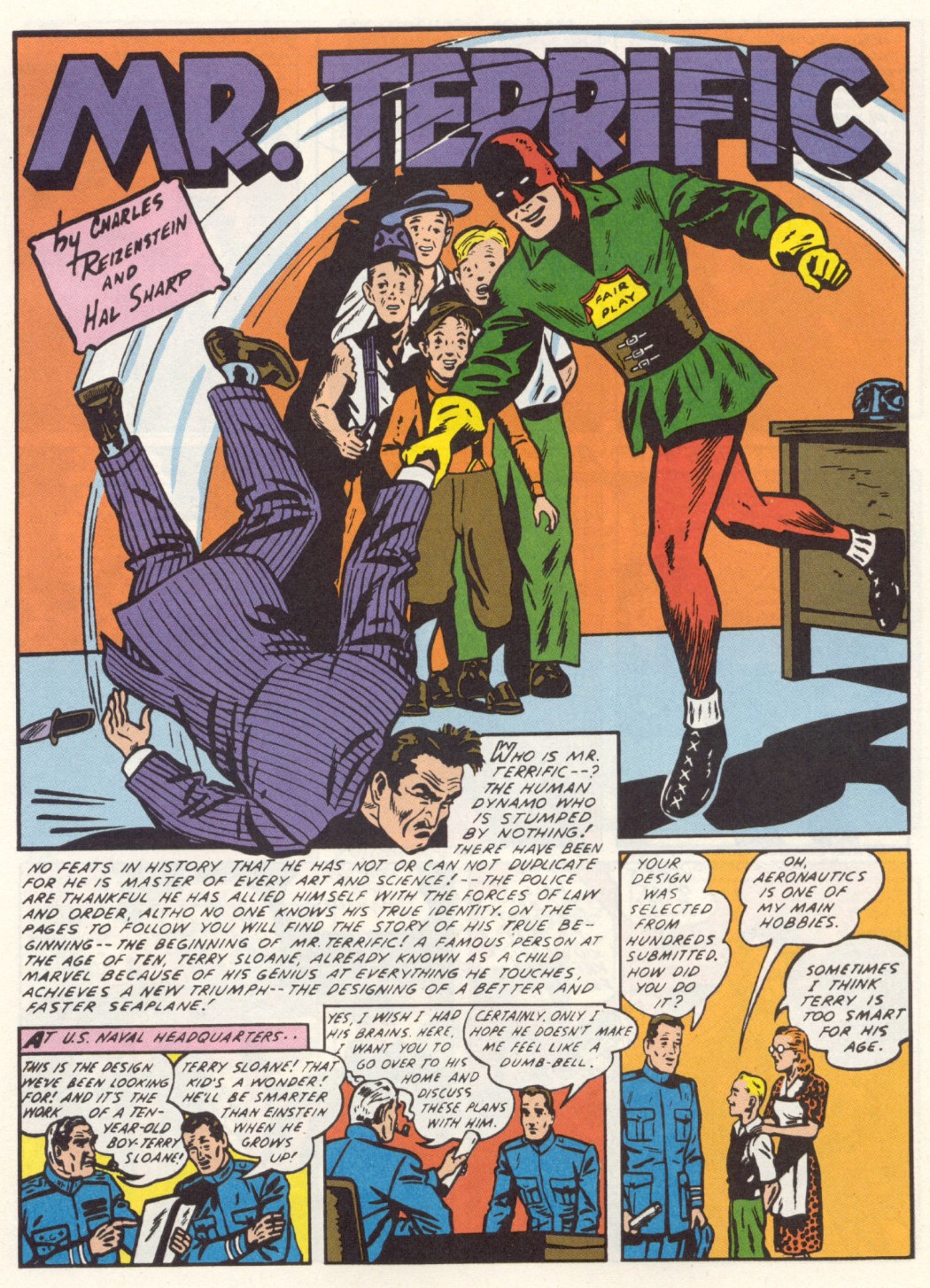 Mr. Teriffic, carrying a name that could only have been bequeathed in the Golden Age, stars in the third feature. Terry Sloane is a genius who’s good at everything, and therein lies the rub. At a young age, he’s crossed off every item on his bucket list. There are no new adventures for him. He’s on the verge of suicide – not out of despair, it seems, as much as out of the determination that death is the only frontier he hasn’t conquered – when he happens upon a young girl who is committing suicide out of despair. Terry saves her, and then goes on to create a costumed alter ego in order to solve her problem – her little brother’s fallen in with a gang. (Anyone who thinks gangs are a new problem should read comics from the 40s. If you were a boy in America, you were either in a gang, being victimized by a gang, or fighting a gang, at least in the comics.) Garbed in red and green with the words “Fair Play” emblazoned on his chest, Mr. Teriffic, genius and athlete, solved crime by way of personal excellence. Like Wonder Woman, he was destined for Justice Society membership, albeit briefly. The tradeoff being that Mr. T. never had to suffer the indiginity of being the group’s “secretary.” The few times he showed up with the JSA, he was part of the action.
Mr. Teriffic, carrying a name that could only have been bequeathed in the Golden Age, stars in the third feature. Terry Sloane is a genius who’s good at everything, and therein lies the rub. At a young age, he’s crossed off every item on his bucket list. There are no new adventures for him. He’s on the verge of suicide – not out of despair, it seems, as much as out of the determination that death is the only frontier he hasn’t conquered – when he happens upon a young girl who is committing suicide out of despair. Terry saves her, and then goes on to create a costumed alter ego in order to solve her problem – her little brother’s fallen in with a gang. (Anyone who thinks gangs are a new problem should read comics from the 40s. If you were a boy in America, you were either in a gang, being victimized by a gang, or fighting a gang, at least in the comics.) Garbed in red and green with the words “Fair Play” emblazoned on his chest, Mr. Teriffic, genius and athlete, solved crime by way of personal excellence. Like Wonder Woman, he was destined for Justice Society membership, albeit briefly. The tradeoff being that Mr. T. never had to suffer the indiginity of being the group’s “secretary.” The few times he showed up with the JSA, he was part of the action.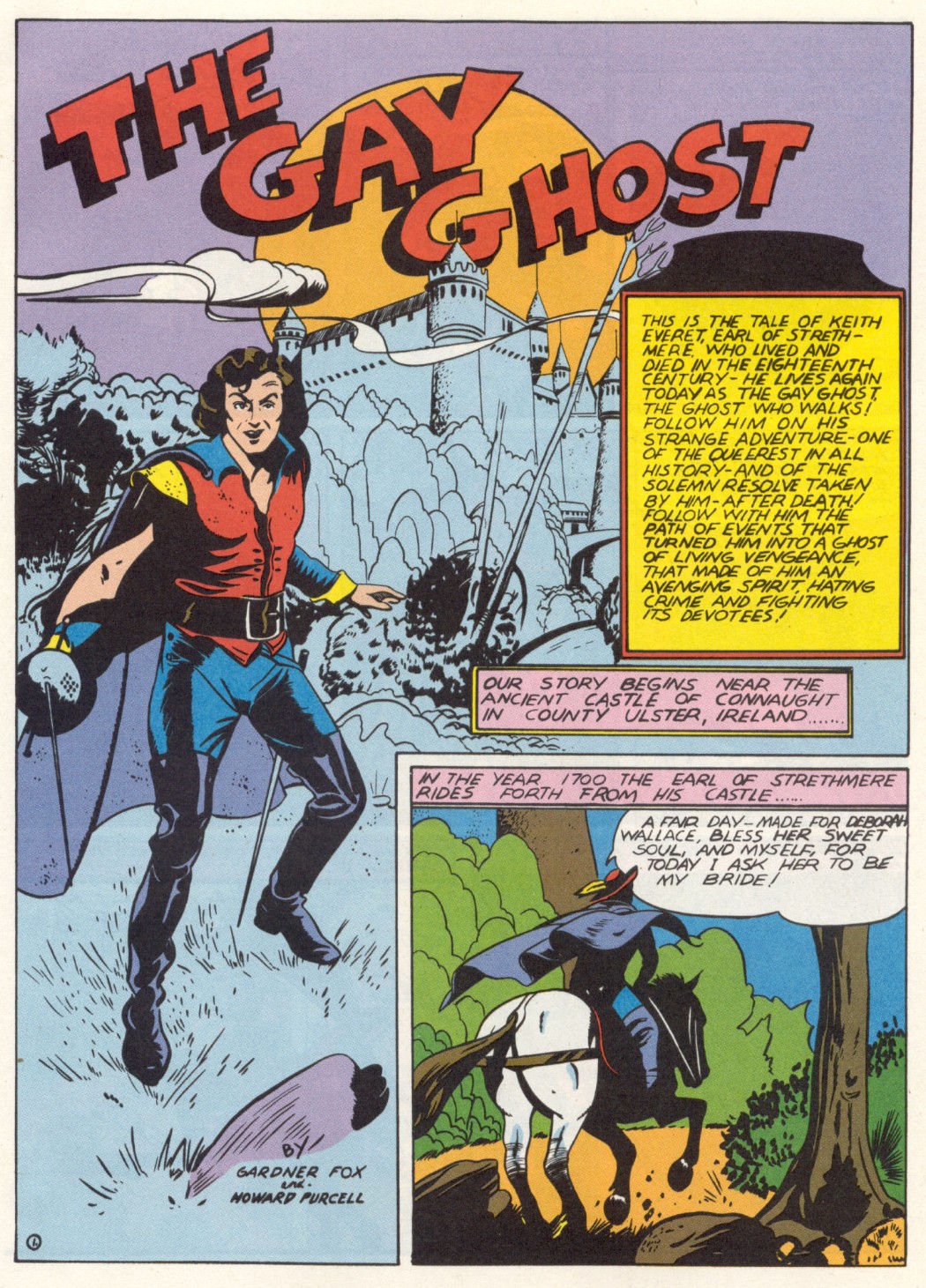 The Gay Ghost is a favorite of mine. No, seriously. The name makes us laugh now, of course, because it didn’t refer to the titular spectre’s sexuality. It just meant he was, like Robin Hood and all the other swashbucklers, a daredevil who laughed at danger. This strip was pulled straight out of Holloywood epics which starred he likes of Errol Flynn and Tyrone Power. Keith Everett, an 18th-Century nobleman, is brutally murdered by thieves one fateful day. His restless spirit, thirsting for justice, is empowered by the spirits of his noble forebears to avenge evil, and thus returns to earth to possesses the body of a kinsman in the20th Century. When there is evil afoot, the Gay Ghost leaps from the body, leaving it helpless, and uses his supernatural powers to right the wrongs he encounters. No one suspects that his now-narcoleptic flesh and blood form hides a spiritual avenger. The Gay Ghost is visible to his opponents, and appears in period dress. So again we have a costumed hero with special powers and a secret identity. The whole shtick is a bit reminiscent of The Spectre, and the astral avenger in green outlasted the Gay Ghost by a long measure. Yet I prefer the less grim, less absurd tone of the The Gay Ghost. (Ironically, when a few of the strips were reprinted in the 1970s, DC elected to rename the character “the Grim Ghost,” and all of their references to him since have used this name. More ironically, Spectre scribe Michael Fleischer created an original character called “the Grim Ghost” for Atlas Comics shortly thereafter. In the degrees-of-separation department, Michael and I had writing credits in the same issue of DC’s Warlord in 1988, but they were separate stories and we’ve never met.)
The Gay Ghost is a favorite of mine. No, seriously. The name makes us laugh now, of course, because it didn’t refer to the titular spectre’s sexuality. It just meant he was, like Robin Hood and all the other swashbucklers, a daredevil who laughed at danger. This strip was pulled straight out of Holloywood epics which starred he likes of Errol Flynn and Tyrone Power. Keith Everett, an 18th-Century nobleman, is brutally murdered by thieves one fateful day. His restless spirit, thirsting for justice, is empowered by the spirits of his noble forebears to avenge evil, and thus returns to earth to possesses the body of a kinsman in the20th Century. When there is evil afoot, the Gay Ghost leaps from the body, leaving it helpless, and uses his supernatural powers to right the wrongs he encounters. No one suspects that his now-narcoleptic flesh and blood form hides a spiritual avenger. The Gay Ghost is visible to his opponents, and appears in period dress. So again we have a costumed hero with special powers and a secret identity. The whole shtick is a bit reminiscent of The Spectre, and the astral avenger in green outlasted the Gay Ghost by a long measure. Yet I prefer the less grim, less absurd tone of the The Gay Ghost. (Ironically, when a few of the strips were reprinted in the 1970s, DC elected to rename the character “the Grim Ghost,” and all of their references to him since have used this name. More ironically, Spectre scribe Michael Fleischer created an original character called “the Grim Ghost” for Atlas Comics shortly thereafter. In the degrees-of-separation department, Michael and I had writing credits in the same issue of DC’s Warlord in 1988, but they were separate stories and we’ve never met.)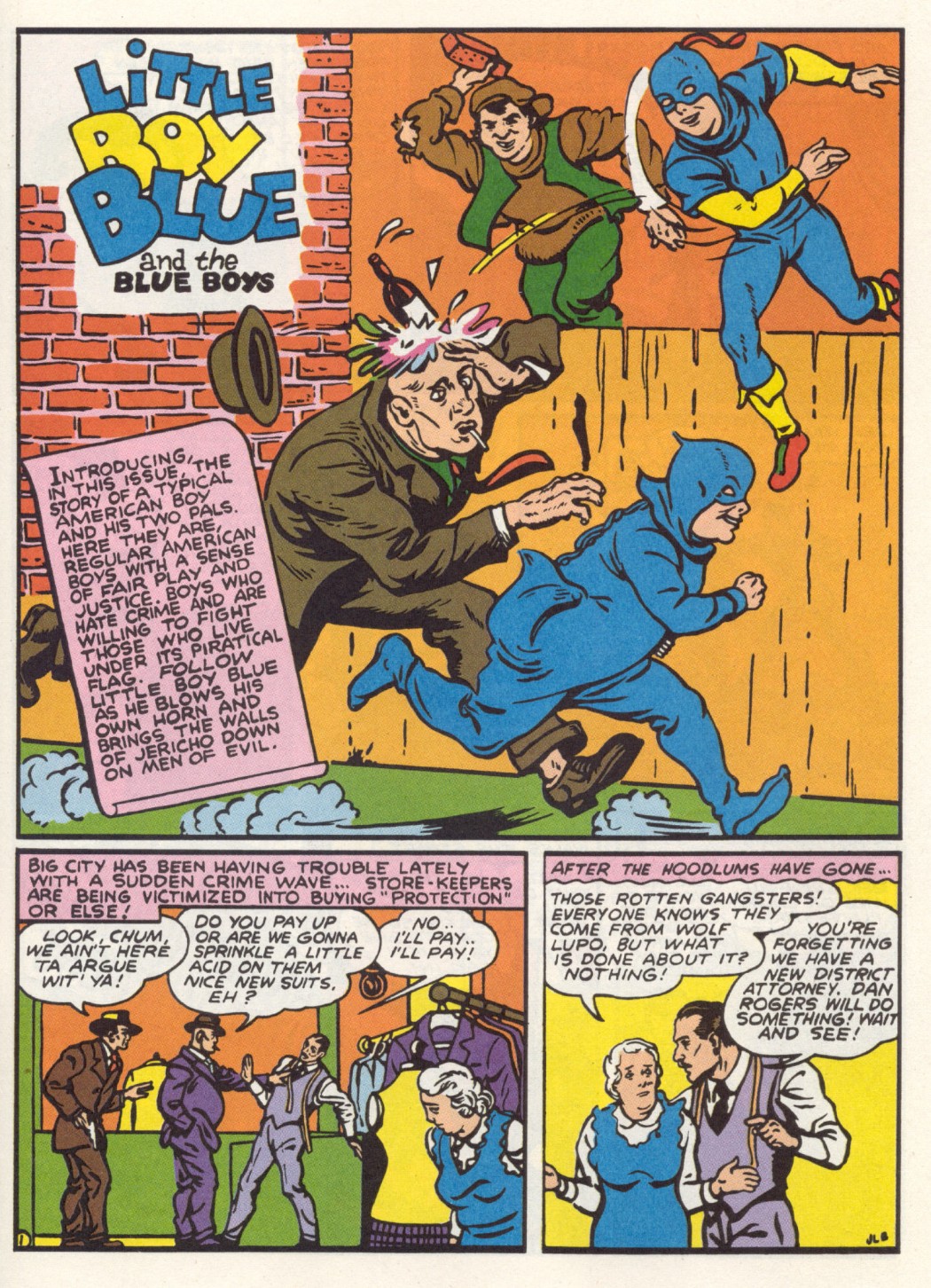 The kids got their six pages in the limelight next, with Little Boy Blue and the Blue Boys: three pre-teens who dress up in costumes to help Little Boy Blue’s D.A. father bust a crime ring. The boys are inspired by the comic book character Wildcat, whose first appearance actually immediately followed the Blue Boys’ in that very issue. Talk about circuitous definitions! On first reading it baffled me that the boys could be reading the same issue I was and yet somehow not notice they were starring in it! I realize now, of course, that the adventures I was reading took place in a parallel universe on a world called Earth Two, and the Earth Two edition of Sensation Comics #1 did not feature Little Boy Blue. I wonder how it filled those six pages?
The kids got their six pages in the limelight next, with Little Boy Blue and the Blue Boys: three pre-teens who dress up in costumes to help Little Boy Blue’s D.A. father bust a crime ring. The boys are inspired by the comic book character Wildcat, whose first appearance actually immediately followed the Blue Boys’ in that very issue. Talk about circuitous definitions! On first reading it baffled me that the boys could be reading the same issue I was and yet somehow not notice they were starring in it! I realize now, of course, that the adventures I was reading took place in a parallel universe on a world called Earth Two, and the Earth Two edition of Sensation Comics #1 did not feature Little Boy Blue. I wonder how it filled those six pages?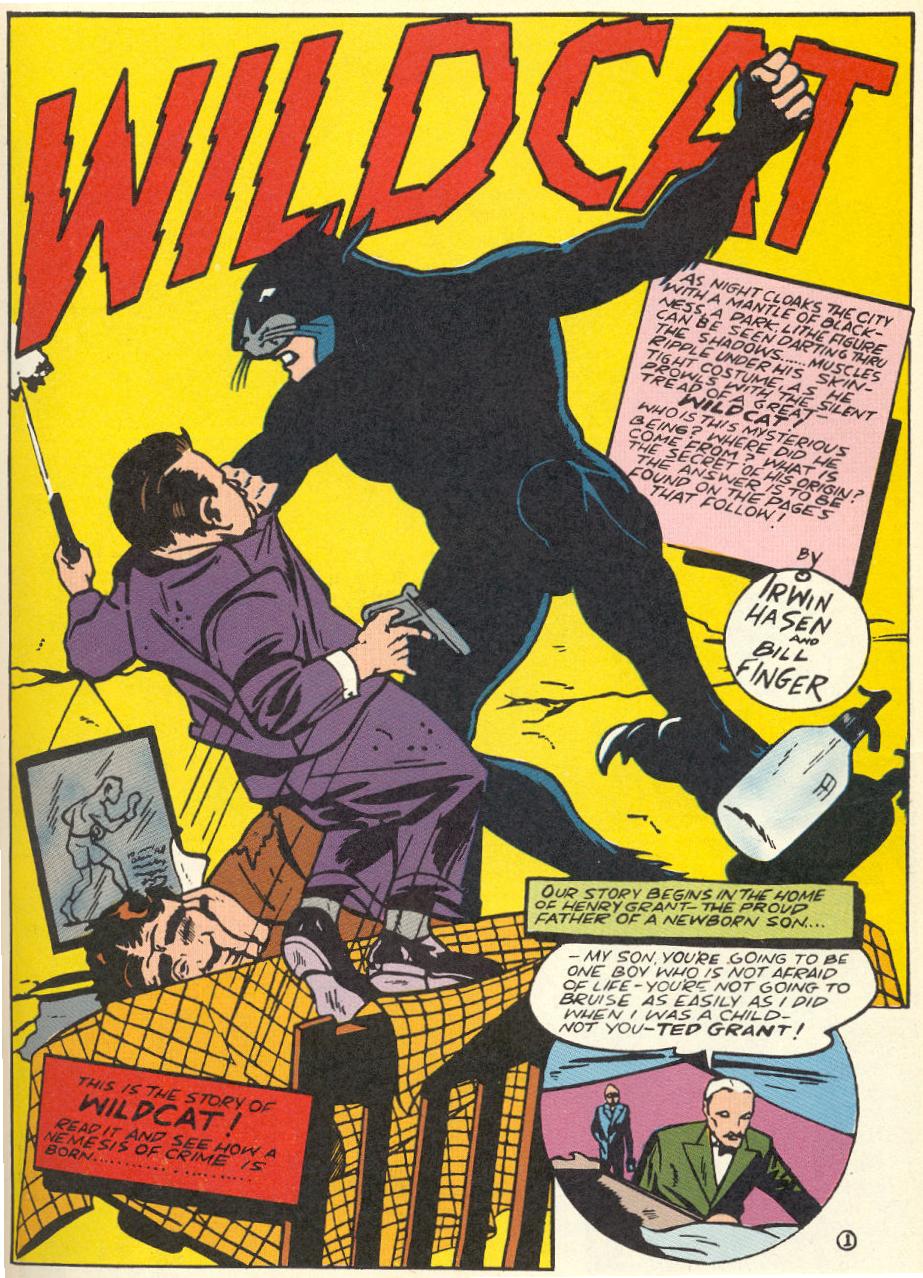 Wildcat was the final feature, and I’d argue the most durable. Ted Grant was a boy trained by his father to not be afraid of physical action, yet this undefeated boxer wanted to be a doctor. His parents’ death left him unable to afford medical school, causing Ted to take a job doing what he did well. No sooner had he become a prize-fighter, however, than he was framed for murder. A chance encounter with a little boy whose comic book has been stolen causes Ted to learn of the existence of the Green Lantern, a super-hero in another National publication. This gives Ted the idea to dress up like a Wildcat (in black… not sure why, since the most common wildcats are not black; but Ted was a city boy, and the black looked coool)
Wildcat was the final feature, and I’d argue the most durable. Ted Grant was a boy trained by his father to not be afraid of physical action, yet this undefeated boxer wanted to be a doctor. His parents’ death left him unable to afford medical school, causing Ted to take a job doing what he did well. No sooner had he become a prize-fighter, however, than he was framed for murder. A chance encounter with a little boy whose comic book has been stolen causes Ted to learn of the existence of the Green Lantern, a super-hero in another National publication. This gives Ted the idea to dress up like a Wildcat (in black… not sure why, since the most common wildcats are not black; but Ted was a city boy, and the black looked coool)“Most durable?” Yes. For though Wonder Woman went on to star on SuperFriends, Slurpee cups and three seasons of television, the version of the character being written and drawn today bears so little resemblance, spiritually, to the gentle woman of peace who headlined Sensation #1 that she might as well have a different name. “Ass-kicking Woman” would be appropriate. Or, if you want something alliterative, perhaps “Decapitation Damsel.” Wildcat, on the other hand, is pretty much still who he was. He’s acquired a literal “nine lives” over the years, and he’s played more as the dumb tough guy than as the kid who was gonna be a doctor. Still, he’s survived the destructions of multiple universes and infinite crises. At last report, he was still active in the Justice Society despite being nearly 90. Rumor has it DC will soon bring back the JSA. I have no doubt he’ll be among them.
The self-referential inspirations for the stars of the final two strips suggest that comics had not only become ingrained enough in the American consciousness that it was plausible for the characters to be aware of the phenomenon, but that a certain tongue-in-cheek attitude had evolved among the creators. It had become okay for them to slip some in-jokes in for their young fans. This strikes me as a sign of a genre “finding itself.” The focused theme of Sensation – that all its characters wore costumes, hid their identities, and consciously fought evil, rather than just encountering dangerous situations, makes it an example of a book that, from the start, was in step with what was to come in the comics industry. And, although Golden Age art is often lampooned and dismissed as crude in this day of high-quality paper, painted pages and computer-generated graphics, there’s a high level of professionalism and skill evident in each offering contained herein.
The day after I read this comic for the first time, I dragged my cousins back to the 7-11 and bought my first comic book off the rack. (For 20 cents. Amazing.) I also bought that second Wonder Woman Slurpee cup. Good thing, because one of the two got struck by hairspray at some point. Never spray a Slurpee cup with hairspray. You may quote me. And very soon after I went home from my Uncle’s house I ordered my own copy of the oversize, 1974 “Bronze Edition” reprint of Sensation #1. It’s still one of the prizes of my collection, currently numbered at something over 10,000 issues. It’s a shame that not only the book, but most of its cast never made it past the 1940s.
REVIEW – Sensation Comics #1 – The Perfect Golden Age Comic Book
(Visited 384 times, 1 visits today)

Pingback: Back in the Day, I Liked…Ghosts #30 - Steven H. WilsonSteven H. Wilson